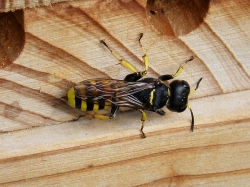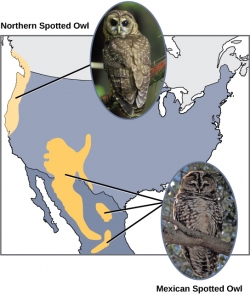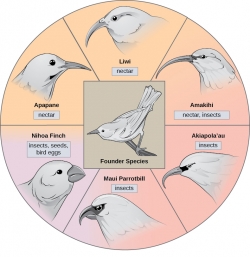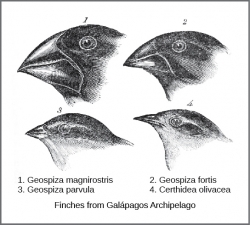There are many different kinds of living things. Even in one group, there are species that can look very different on the outside and inside from the other members of their group. A
species is a group of living things who can have children with each other that will also be able to grow up and have their own children. In other words, your little brown dog and your friend's large white dog may look different, but they are still all part of the same species because they are both dogs. Living things need to have children with the same species. They can't have children with a different group of animals because they are too different from one other. At some point though, all living things came from the same relative, so they all had to change somewhere along the way. Let's look at how these changes have happened to make all of the different living things on Earth.

This organism is a member of a species, a group with DNA similar enough to reproduce and make offspring.
gailhampshire at Flickr.com
SpeciationLooking at all of the different kinds of living things, we know there had to have been a way for new living things to come about.
Speciation is the formation of two different groups from one original group that can no longer have children together. One species can be separated into two or more different places. This can make them change because of the different weather, food, or other kinds of living things they have to fight with to live. In order for new kinds of living things to come about, two new groups must be formed out of the first group. Then each group would have to change so that they wouldn't be able to have children together.

The diagram illustrates the relationship of elephants from its ancestral species.
Modified from Openstax Concepts of Biology
Geographic Isolation
A group of living things doesn't always live in one small place together. They could live in one large place or they could live in a place that is separated by something, like a mountain or body of water. Groups of living things that live in one large area are often alike in many ways. That is because of their
gene flow, which is when different kinds of traits move around a group of the same kind of living thing without limits. As long as the group can get around the place they live and have children with other living things in their group, gene flow can happen. Once a group is separated and the living things in it can't get to each other, this can't take place. Think about it like this: if there is a group of gray cats that live in the same town that can go anywhere, they would be able to have children and make more gray cats all over town. If the grey cats were separated from other cats and locked in a house, they wouldn't be able to make more cats and would stop the gene flow for gray fur.
If a group is separated for a long time, each group may begin to change in different ways.
Geographic isolation is when a group of the same kind of living thing is split up because of parts of the Earth that they can't cross. This can be a mountain, a large lake or river, or another thing that separates a group. When this happens, the traits that everyone in the first big group once had could change in different ways in each new group. Think of it like this: a huge wall is built in the middle of town. A group of cats on one side of town could begin to get better at jumping up trees to catch birds. There are no trees on the other side of the wall, so those cats need to get better at sneaking up on birds to catch them, instead of jumping.

The northern spotted owl and the Mexican spotted owl inhabit geographically separate locations with different climates and ecosystems.
modification of work by John and Karen Hollingsworth, USFWS and Bill Radke, USFWS
Also, when you separate an area, new conditions can pop up in the different places. This can mean different weather, different places to get food, different animals trying to eat each other, or different animals fighting for that same food and space. When this happens, only the living things that can live long enough to have children will be able to pass on their traits. Over time, the traits that led to living things dying will die out, too. Think about the cats we just talked about. The cats on the side of the wall with trees that couldn't jump to get the birds would die because they wouldn't be able to get food. That means they wouldn't go on to make children that can't jump. The cats that could jump in the trees to get the birds would be able to go on and have children. They would pass on the ability to jump to their children, so in time, only cats that are good at jumping would be in that group. This is called
divergent evolution, or when two kinds of living things both come from the same ancestor, but changed over time because their environments changed.

Divergent evolution: From one original species of bird, multiple others evolved, each with its own distinctive characteristics to suit its environment.
CNX OpenStax, CC BY 4.0 , via Wikimedia Commons
Let's also look at beetles as another case of this. Some beetles in this group are green and some are brown. Let's say the group was separated by a mountain. On one side of the mountain, there is a lot of rain and green plants can grow. This makes it easy for the green beetles to blend in and avoid getting eaten. The brown ones, however, get spotted and eaten up. On the other side of the mountain, the rain is blocked so the plants are brown and dry. On this side, the brown beetles blend in and the green ones are more likely to get eaten. In time, these two species will be totally unique. Each group of beetles would be different from one another, but also different from that first group of beetles that they all came from.
Darwin's Finches
Charles Darwin was one of the scientists that discovered that once a group is divided, each group changes differently over time. Darwin spent time on a group of islands and found that the living things on each island had a lot in common with each other, but were also clearly different. He saw this in the ground finches, a kind of bird, who had a beak shape that was different from the finches on another island.

Darwin observed that beak shape varies among finch species, and proposed that the beak of an ancestral species had adapted over time to help the finches to acquire different food sources.
John Gould (14.Sep.1804 - 3.Feb.1881), Public domain, via Wikimedia Commons
Darwin imagined that the groups of birds on each island all first came from the same group of birds, but diverged, or changed, into many different groups because the water on the island separated them. This meant they all had different food. On some of these new islands, there were a lot of hard seeds to eat. Only the birds with strong beaks would be able to crack open the seeds to get the food. They would be the ones to go on and have children. The birds with small beaks would die out. On another island, the food was found in tall flowers, which meant that the birds needed a long, thin beak to get food. On this island, the birds with short or fat beaks died out, while the birds with thin, long beaks went on to have children because they could get to the food.
References
Adapted by the RocketLit team from: